Jerry Jenkins
We have 8 or 9 species of birches in the Northern Forest Region, out of about 35 to 50 in the world and 18 in North America. Ours include three white-barked trees, two dark-barked trees, and three or four shrubs. They are familiar, and, if you stay away from the shrubs, usually easy to identify. But this ease is, in fact, an illusion. If you start looking you find not only unidentifiable individuals but whole unidentifiable populations. If you look at the literature, you will find that you are not the only person who has been puzzled by them.
A group this variable and this interconnected poses some Big Questions. Does hybridization create new species, or blur the lines between existing species, or both? If the latter, can species boundaries break down altogether? And, in the long view, is there any difference between “natural” intra-species variability and the traces of old hybridizations? I can’t, of course, answer any of these, but I like to think about them.
The birches are a good group for doing this. On the one hand, the species often look very clear. On the other, the variant populations that interconnect them are easy to find. Hence these notes, illustrating our three white-barked species, which are good when they are good, and two variant populations, which were not good at all.
The white-barked birches in theNorthern Forest Region are gray birch, Betula populifolia, a diploid; heart-leaved birch, B. cordifolia, apparently diploid and tetraploid; and paper birch, B. papyrifera, tetraploid, pentaploid, and hexaploid. Elsewhere in North America, there are two more: Alaskan birch, B. neoalaskana, a diploid, and Kenai birch, B. kenaica, a pentploid. Since the birches are wind-pollinated and outcrossing and the polyploid species probably derived by hybridization and back-crossing among the diploids, we have the material here for a classic taxonomic mess.
To think your way through a polyploid group, start with the diploids. Here are three gray birch leaves from a small tree in Maine.
The leaf form is very distinctive: triangular over all and widest near the base; base straight (“truncate”) or a bit indented (“cordate”); tip elongate and concave-sided; two sizes of teeth (“double-toothed”). Anything with leaves that look like this is definitely a gray birch. If you have the characteristic gray birch bark,
or single, elongate, male catkins and slender twigs with a lot of white resin and bumps, they are good confirmations.
The fruiting catkins of gray birch are relatively short compared to our other white birches.

The cone scales have a short terminal lobe and side lobes that point out, like short-necked birds.
The seeds are small, under 2.5 mm, and their wings are narrow and often narrow to the base.
Heart-leaved birch is a northern species, said to be both diploid and tetraploid. It is found from Atlantic Canada to western Ontario and also in northern New York and New England. It is also called mountain birch, and something resembling it is found at higher elevations, mostly over 2,500 feet, in New York and New England. These plants puzzle me, and I need to see more of them.
I know it best from boreal forests near the coast in eastern Maine and New Brunswick. Here is a montage of the leaves from five trees on Quoddy Head, ME, selected to show the range of variation.
The leaves vary from oval to rounded triangular, have a short acumimate tip, vary from weakly to strongly double-toothed and, at least when large, have cordate bases. Compared to the gray birch leaves their tips are shorter, the large teeth less pronounced, the bases more often cordate, and the greatest width is higher up.
The bark is typically shiny red-brown bark when young and often pink-white or silver-bark at maturity. Here are two small trees from Great Wass Island, a few miles west of Quoddy, with silver-white bark.
And here, from Fundy National park, N.B., is one with pink and silver bark.
Heart-leaved birch has multiple male catkins, and female cone-scales with forward-pointing lobes, resembling (perhaps suspiciously), those of yellow birch.
The seeds have large frilly wings and long stigmas. They look like tiny moths.
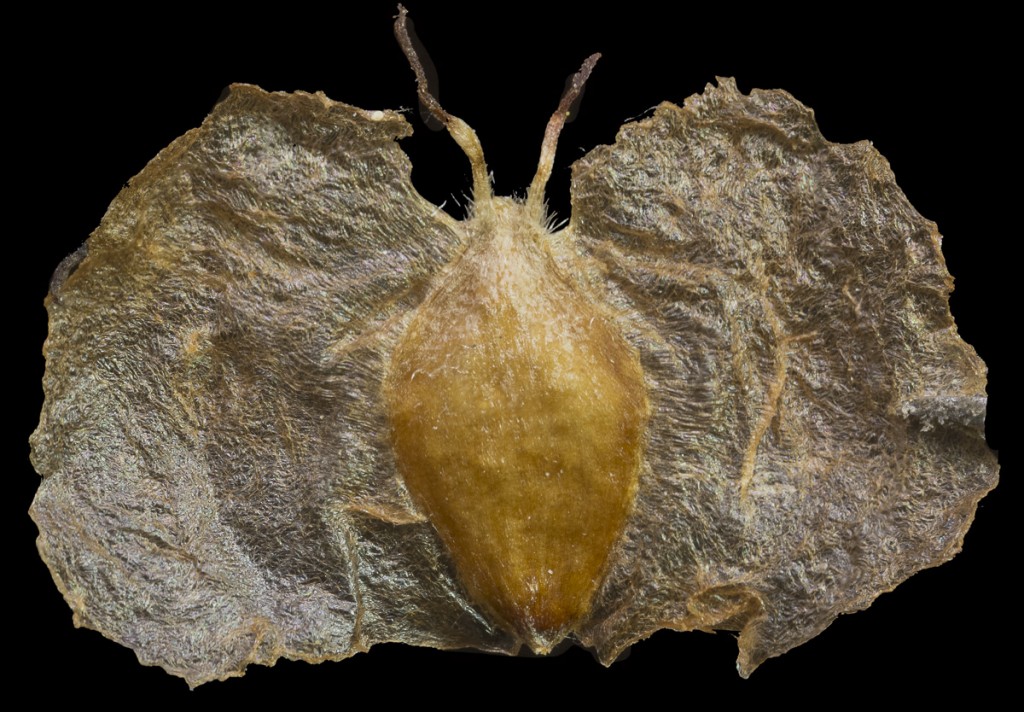
Heart-leaved birch has long been controversial. Current floras and checklists of Minnesota, New York, Canada, Vermont, Nova Scotia, North America, and New England consider it a species. Those of Wisconsin and Michigan consider it a variety. The plants in eastern Maine and New Brunsick seem distinct in seeds and cone scales and at least somewhat distinct in leaves and bark. As birch species go, they seem worth recognizing.
The problem gets worse quickly when you don’t have fruits, or when the the fruits are high up and you can’t get them. Here, for example, are three birch lives picked off the ground near Branch pond, Sunderland, VT. They were in a grove of tall birches with somewhat gray bark and represent the common leaf type on the ground.
These match the leaves from Quoddy pretty well. It seems likely to me, especially because they were so common, that there are heart-leaved birch birches here. But, because there are paper birch leaves on the ground too, I can’t be sure which tree is which. And without fruits, I am not really sure whether there is true heart-leaved birch or just paper birch with heart-shaped leaves. Single characters are interesting, but they make poor species.
The big problem, of course, is separating heart-leaved birch and paper birch. Paper birch is a complex and variable species. It has a continental range, close relatives in western North America, Europe, and Asia, and tetraploid, pentaploid, and hexaploid chromosome numbers. It was doubtless derived by hybridization between diploid ancestors, but we have no idea who those ancestors were. Molecular work places it close to Betula populifolia, cordifolia, nana, occidentalis, and glandulosa. It is believed to hybridize with alleghaniansis, neoalaskana, keniaca, pumila, populifolia and cordifolia.. We may expect it to resemble those species and, by backcrossing, serve as an evolutionary conduit through which genes pass between them.
Here are two sets of paper birch leaves, from mature trees with chalky-white bark in New York and Maine.
Compared to the heart-leaved birch, their leaves are more rounded overall and often have a rounded base. They only rarely have a heart-shaped base.
Here is typical mature bark. Young bark is dark, and in-between bark, which you see a lot of in the mountains, variously red, pink, or cream.
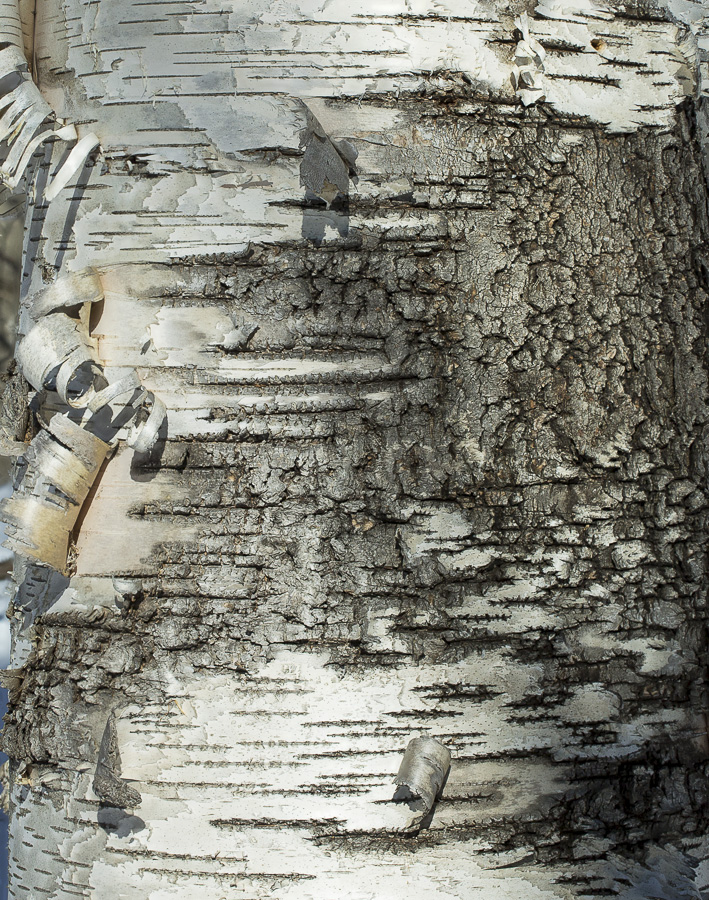
The New York tree was fruiting. Its cone scales had broad, outwardly pointed side lobes and a shorter and broader terminal lobe.
Its seeds were smaller than those of heart-leaved birch, with shorter stigmas and narrower, less ruffly wings.

If all white birch leaves we saw matched one of the three types above, and if we always had fruits to confirm our identifications, the white birches would be easy and I’d be done. Unfortunately, they don’t and we don’t and so things get sticky. I’ll show you two examples out of many.
Back at Branch Pond, the heart-leaved birch leaves were from big trees in upland woods. On the pond shores and in the adjacent boggy meadows (see a map here), there are many small birches, a 1 to 3 meters tall. They grow in sphagnum hummocks and are regularly harvested by beaver. They do not, overall, have easy lives. I have not found any fruits on them but have found the single male catkins and bumpy twigs of gray birch. Here is a montage of the leaves from five of them.
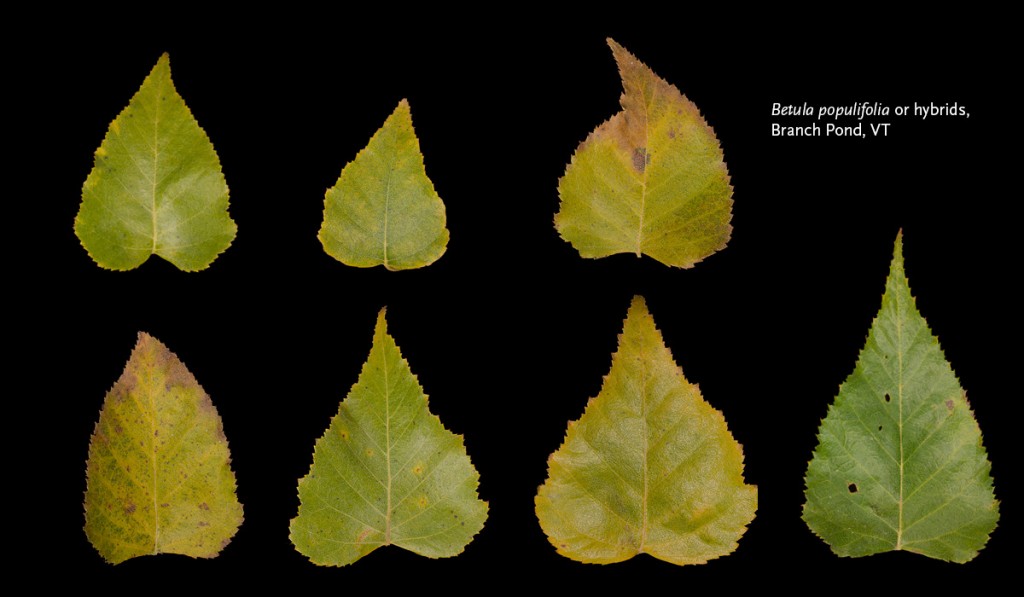
Overall the leaf-shape resembles gray birch, but with shorter tips, less double toothing, and consistently cordate bases. The leaf shapes differ from tree to tree. Some are consistently triangular and double toothed, others more rounded and single toothed. Some look like gray birches, or at least unhappy gray birches. Others don’t look like gray birches at all.
Gray birch and heart-leaved birch birch come out as sister species in molecular phyllogenies, and are known to hybridize. It is possible that some of the trees in this population are hybrids or back-crosses (“introgressants”) between hybrids and gray birch. It is also possible that they are just stressed gray birch with odd leaves.
Either way, these plants are common enough on pond shores and in beaver flows that I have a name for them—beaver-pond birches—and consider them a regular part of our flora. They are especially common in eastern Maine. Two weeks ago ago I collected a series of leaves from small birches along a logging road in Maine. They ranged from 1.5 to 10 meters high and from brown to white bark. Some were sprouts, and some saplings.Typical gray and paper birches occur nearby. I didn’t see heart-leaved birch, but it could be there. Here is a montage, with three leaves from each of eight plants.
The variety is striking. Some show gray birch characters. Others (middle row, left group) look a lot like paper birch. Some seem to show heart-leaved birch character. And some mix characters I associate with several species.
Some of this we can write off by saying “Sprouts are weird and don’t look at them.” But a lot of these were proper young trees and need more consideration. A minimal explanation might be that:
1 There are likely several genotypes along the road.
2 The leaf characters we use to define the species—overall shape, toothing, shape of base, length of tip—seem to associate freely. We find gray-birch teeth and heart-leaved birch bases on leaves with paper-birch shape.
3 As a result, while some of these leaves appear to be intermediate between two species, others appear to be novel character combinations rather than intermediates.
In any event, they are birches, and I can’t really name them. Fruits and adult bark would help a lot. But none of these trees were fruiting, and most of them had immature bark.
Without bark and fruit characters, we have to rely on leaves and bud characters. Unfortunately, the buds of the white birches are quite similar, and the leaves are quite variable. And thus, until they get older or I get smarter, my conclusions are that: Some birches are identifiable, some are not. Leaves, by themselves, are often indecisive. The more characters you have, the better off you are.
Another way of saying this that a simple taxonomic view—everything is either a species or a hybrid, and the hybrids are intermediate between their parents—doesn’t work very well here. The leaf characters seem to assort independently of the parental combinations, and produce forms that aren’t intermediate between the parents.
In situations like this, instead of separate species and distinct hybrids, it makes sense to talk about a polyploid complex in which the entities are broadly defined and interconnected by hybridization. If we take take the North American species and add relationships and hybrids, the picture looks like this.
The important feature is that everybody is connected to everybody else by hybridization and backcrossing. As a result, the species overlap genetically and morphologically. The boundaries between them blur and it becomes hard to say what is a “true” species and what a hybrid.
This view makes historical sense. The birches are an old group that is now spread through the northern hemisphere. They are outcrossing, live at high latitudes, and had to migrate long distances during the ice ages. Hence they have often been in contact with one another, and, being birches, have made the most of it. The result is what we see today: an active, variable, interrelated, confusing, fascinating group. I commend them to you. Any genus that produces plants that can’t be named is worth getting to know.
J.J., White Creek, New York, 16 October 016
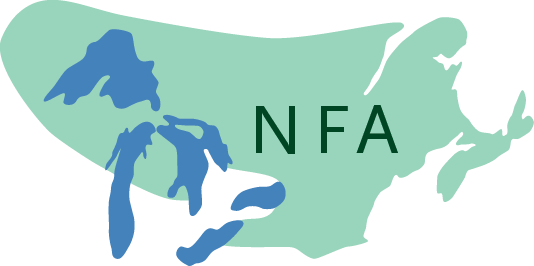
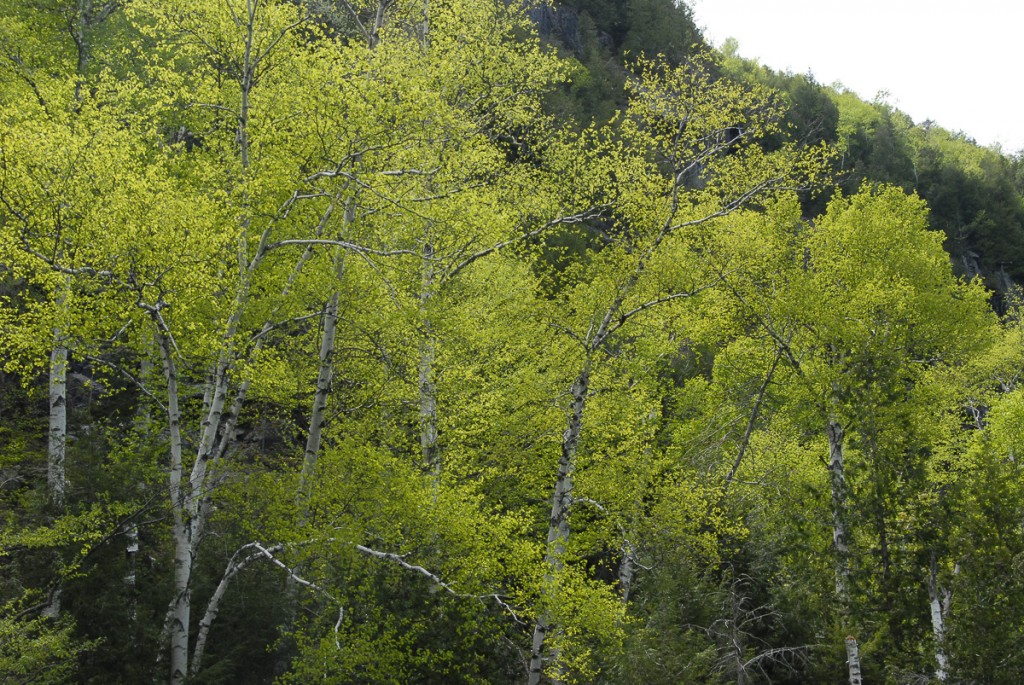
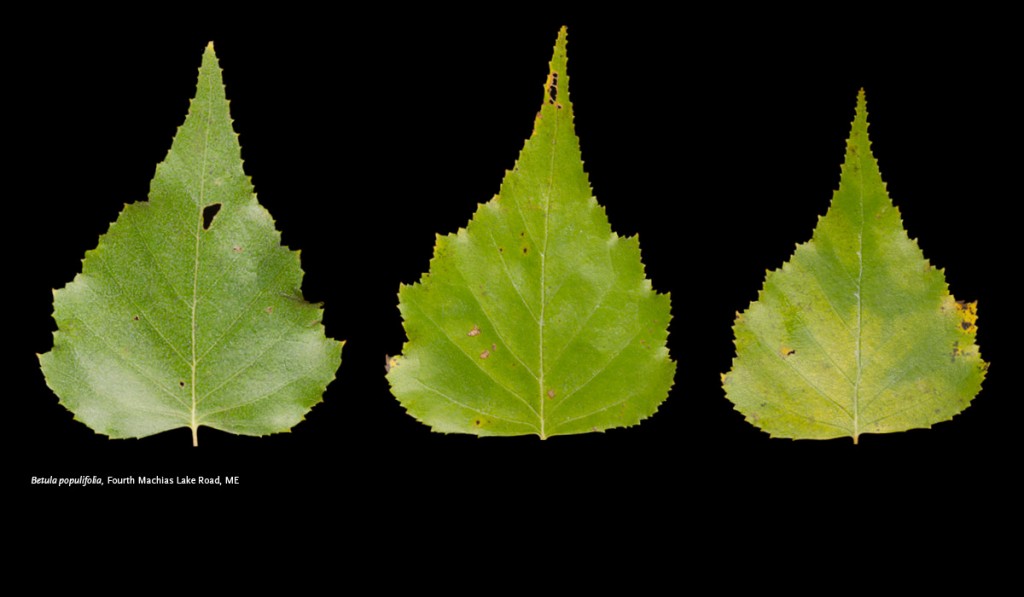
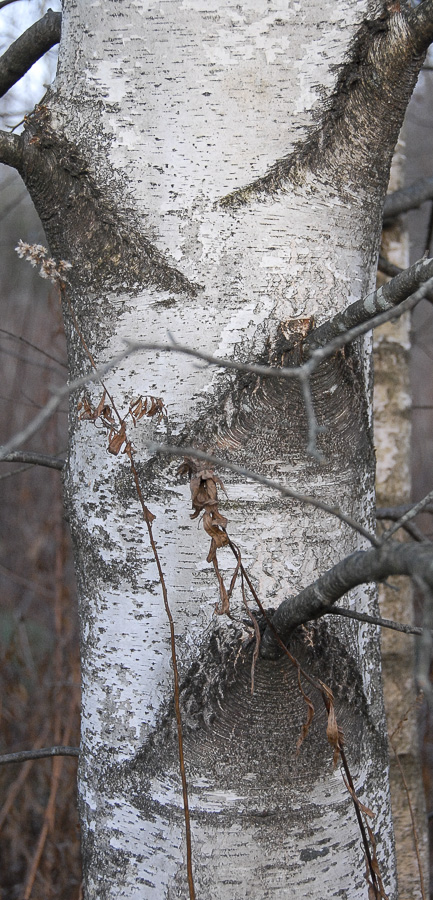

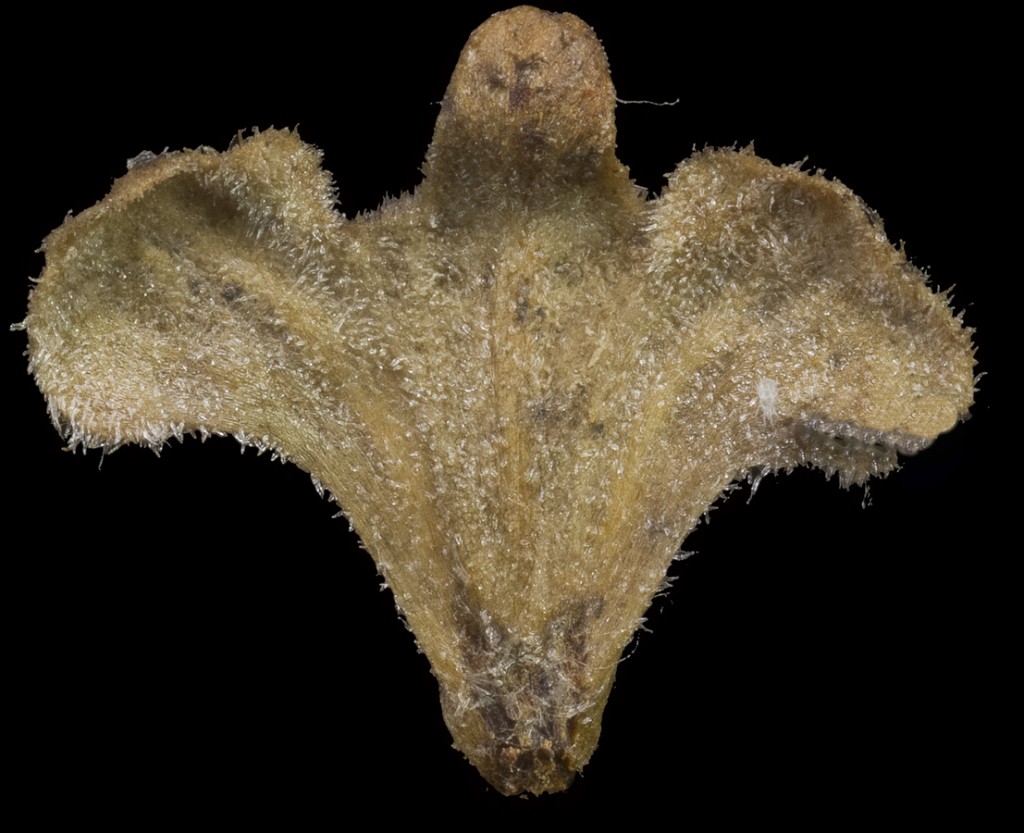
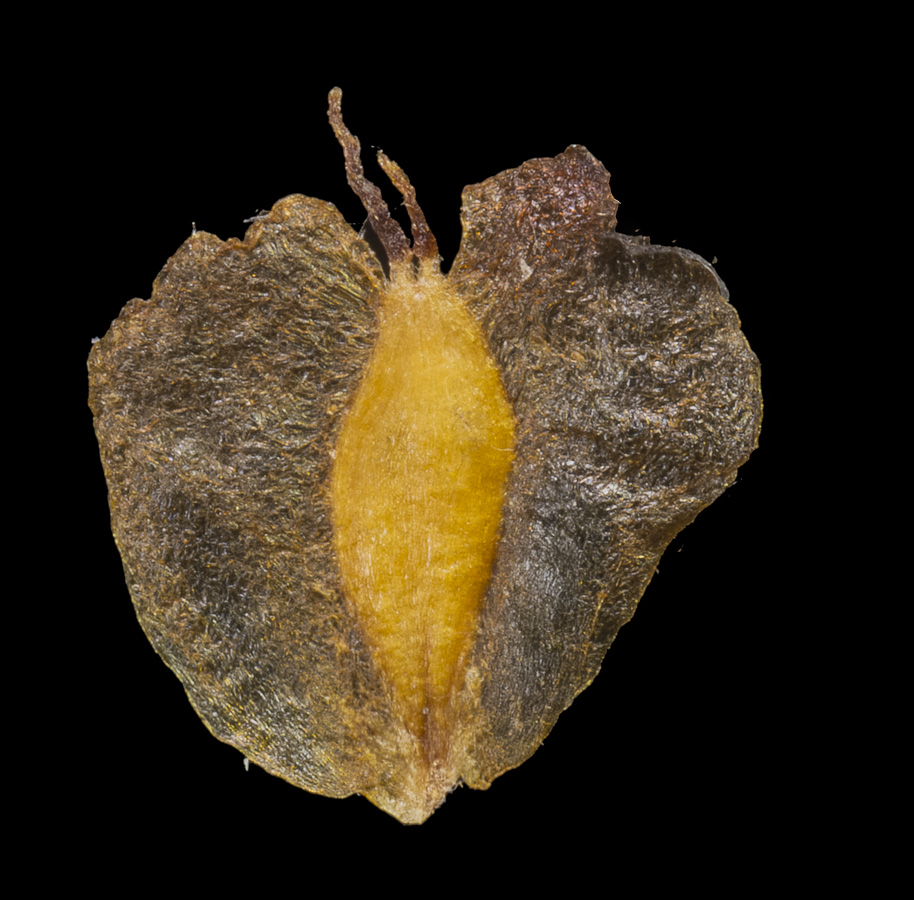
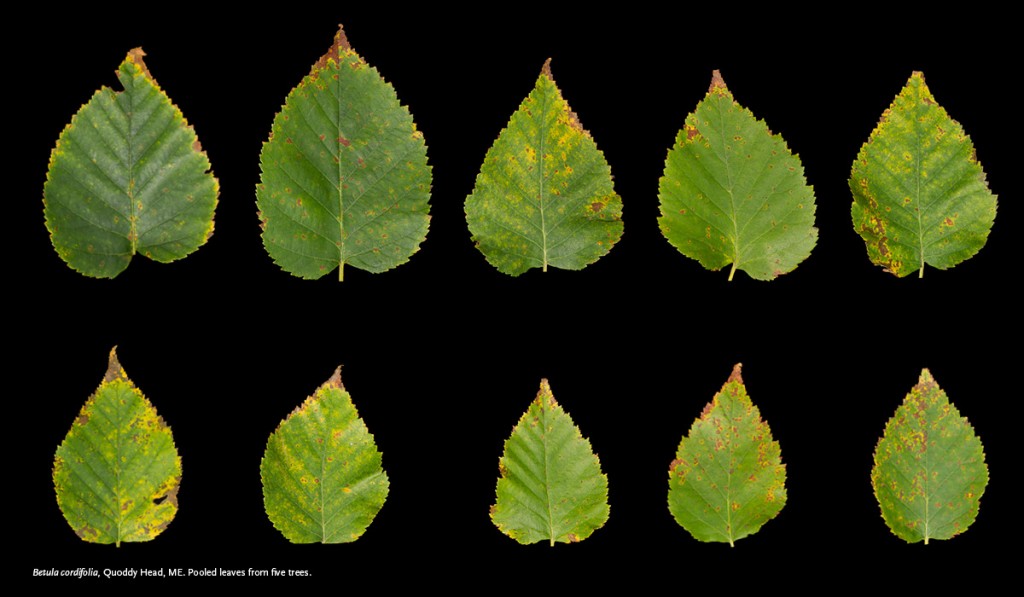
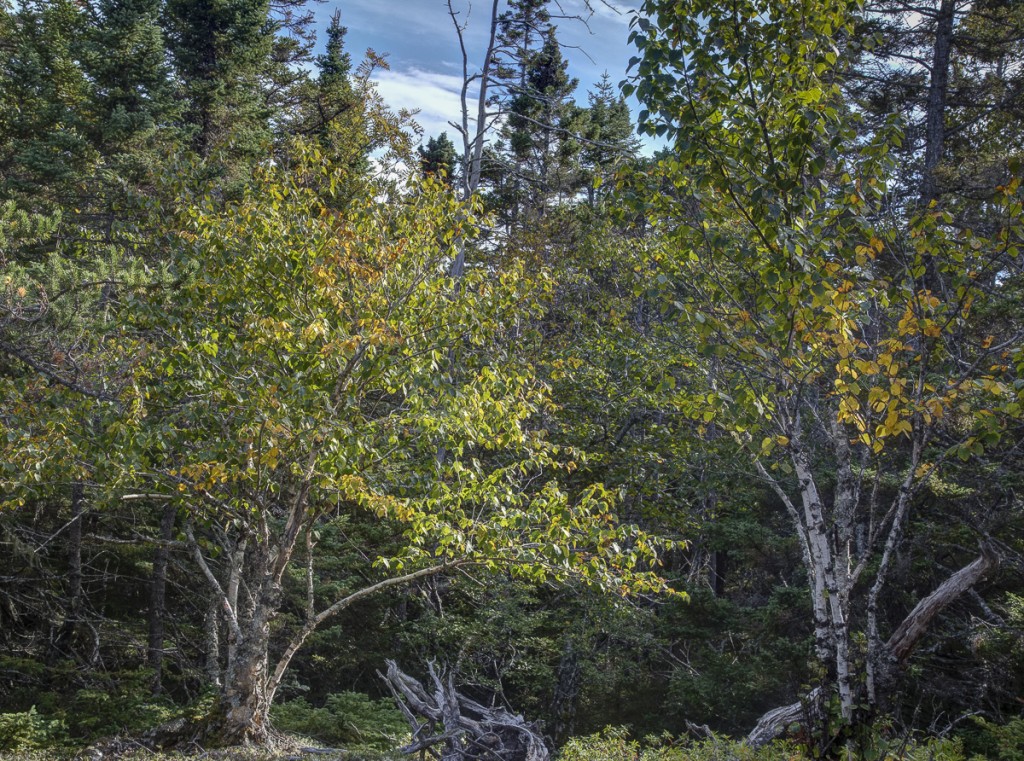
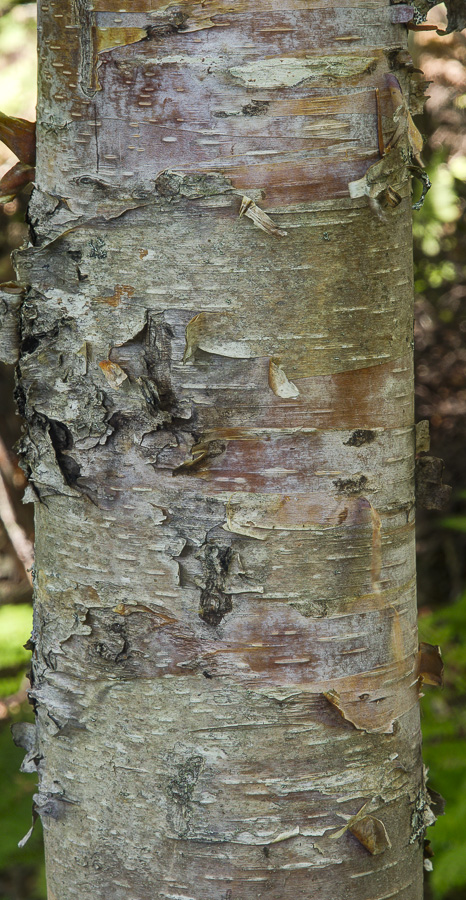
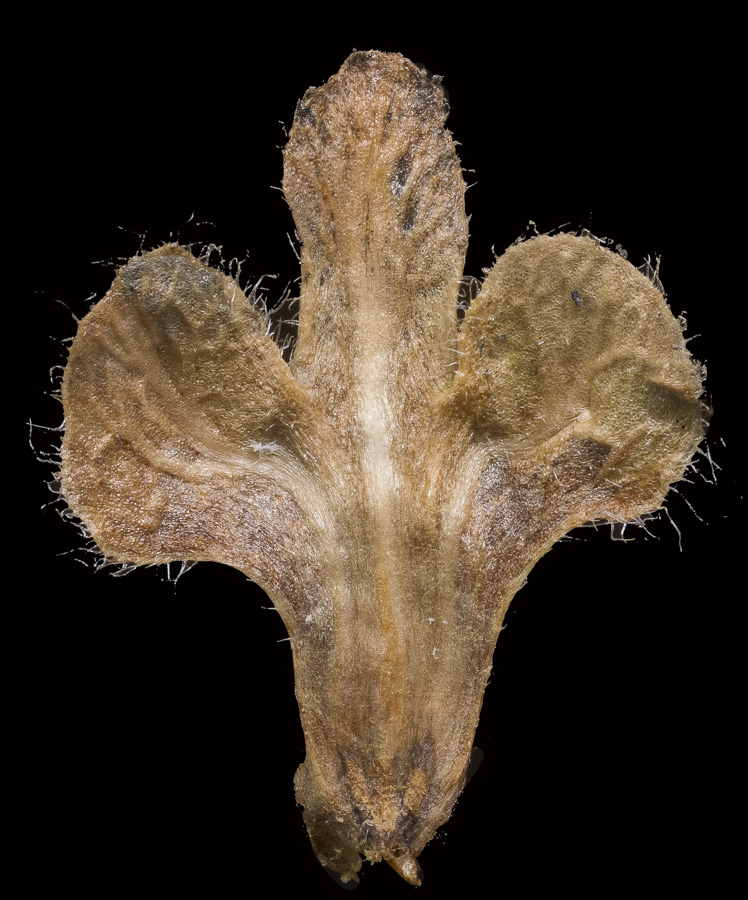
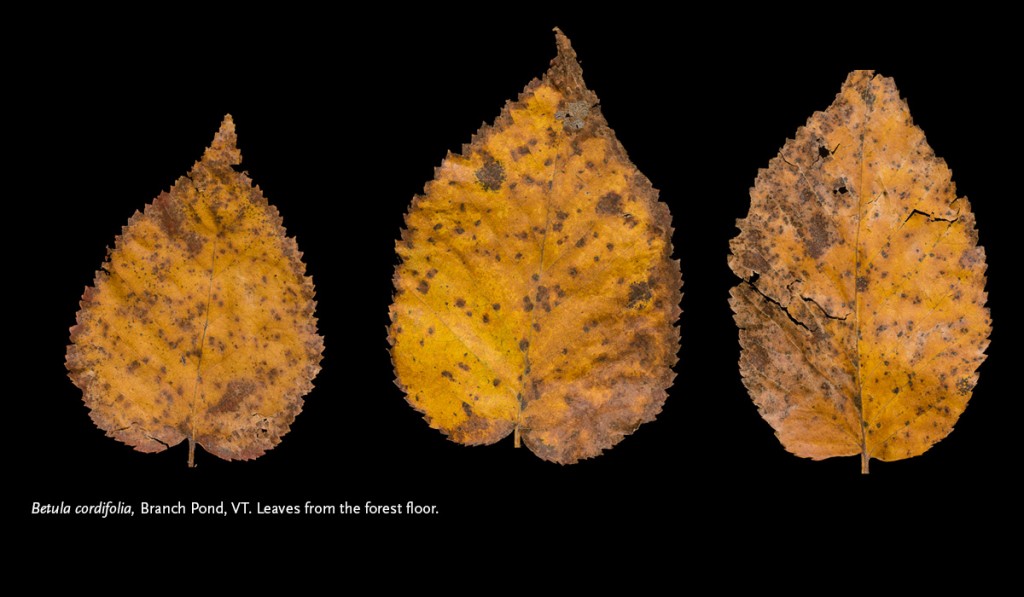
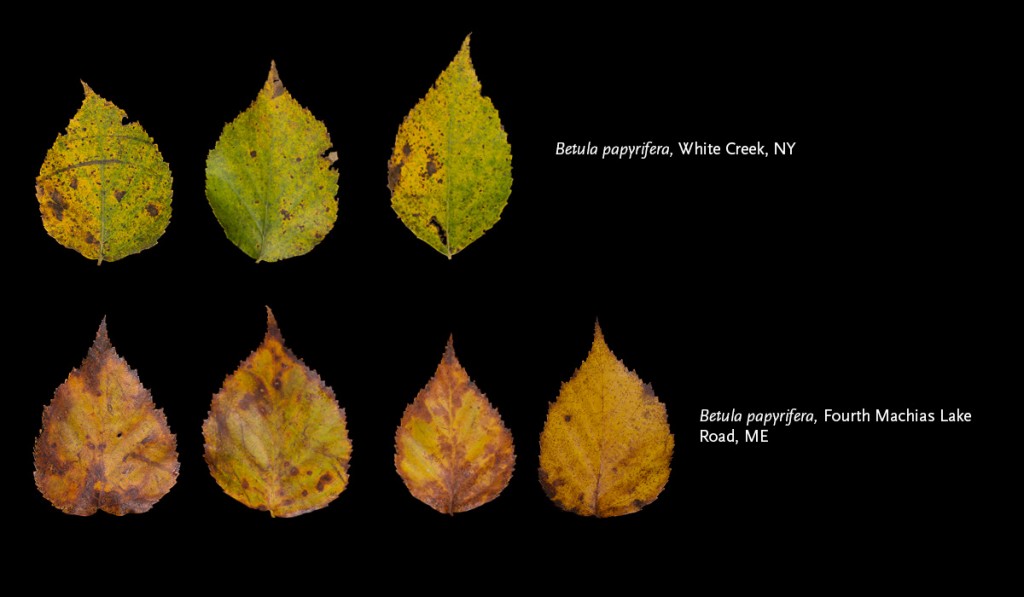
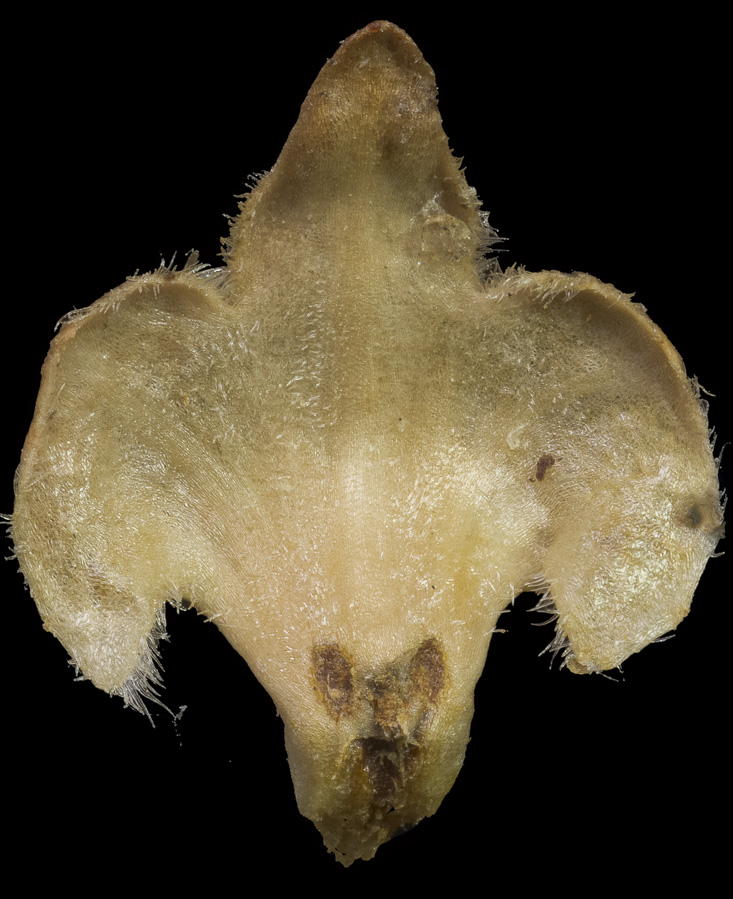
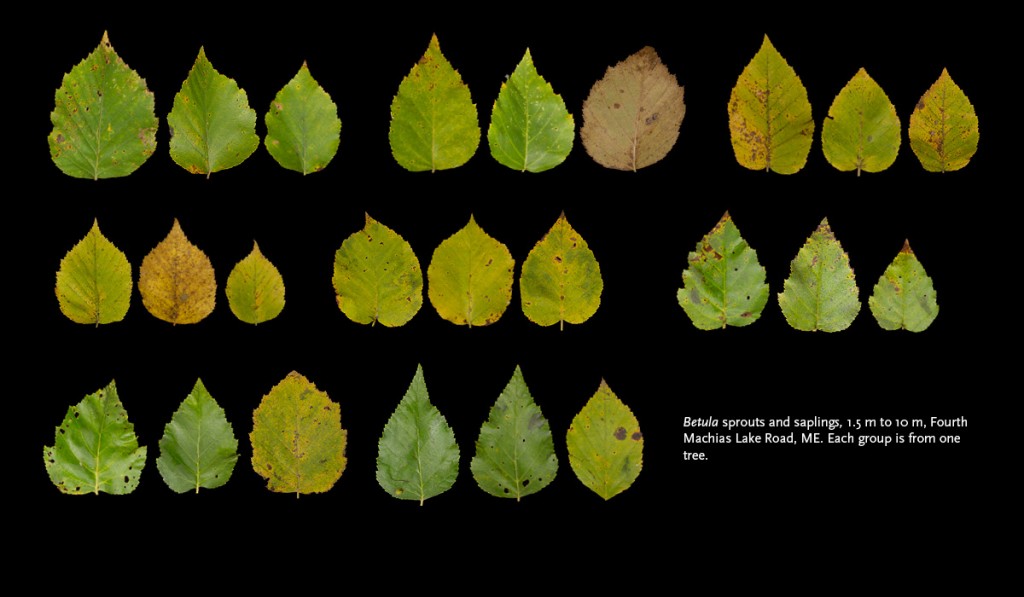
Dear Jerry–I am an old fan and have been delighted to stumble on your more recent work two days ago. I would be ordering some posters for myself and to give, if they were available–will do so later. (Riding my bike over new leaf-fall a month ago I realized I need help identifying them. I think I’ll be tempted to start looking closely at buds and mosses and branching strategies too. Meanwhile have just been browsing on the atlas site and reading your article on the birches and was moved to comment by your humor in commending them to me for being among other things confusing. On another front, I have been puttering ever since your Climate Change in the Adirondacks on what I call LOLA: Long Lake All Local Low Carbon Initiative, whereby I propose that Long Lake should do as that similarly-sized town in England is doing, going as low-carbon as they can, the whole town. It seemed to me that all your recommendations 1)saved money, 2)made money, and 3) created jobs (read, more kids in the school) so what’s not to like? You don’t even have to believe in CC to like them. Bright young people would beat a path to our door. And so on. I’ve written what I call the Foundation Documents, with headings like “No Thanks to Banks” and “Whoevva Hearda NYSERDA?” Well, I don’t try to promote it–it’s been terminal as a conversation starter. But I do remember you at the end of your presentation at the Museum on the publication of the Adirondack Atlas (that tremendous service!) more or less saying, There, I’ve given you some information. Up to you, if anything’s to be done with it.” Hurrah for you, Jerry, for all you have done and go on doing. Information, prresentation, spirit, humor. Bravo.
Mason, Thank you. The carbon conversation is indeed hard to start and hard to make go anywhere. But we do what we can. Think of how far away a million and a half acres of protected & public Adirondack wilderness must have looked in 1890. And how far we have come. And indeed, why shouldn’t Long Lake lead?
J.